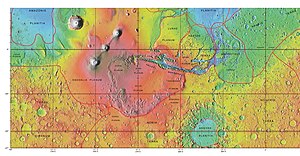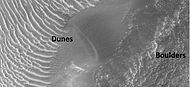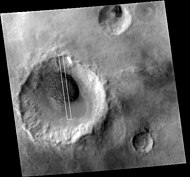263:
322:
167:
215:
203:
231:
283:
350:
338:
310:
247:
147:
438:
187:
367:
28:
20:
262:
298:
Gullies are found on some dunes. These are somewhat different from gullies in other places, like the walls of craters. Gullies on dunes seem to keep the same width for a long distance and often just end with a pit, instead of an apron. Many of these gullies are found on dunes in the
321:
282:
166:
230:
544:
Ruj, T., Komatsu, G., Dohm, J.M., Miyamoto, H. and Salese, F., 2017. Generic identification and classification of morphostructures in the
Noachis-Sabaea region, southern highlands of Mars. Journal of Maps, 13(2), pp. 755–766. DOI:
214:
548:
Ruj, T., Komatsu, G., Pasckert, J.H. and Dohm, J.M., 2018. Timings of early crustal activity in southern highlands of Mars: Periods of crustal stretching and shortening. Geoscience
Frontiers.
309:
429:
146:
349:
202:
246:
374:
288:
Close-up of a gully showing a channel going across the apron, as seen by HiRISE under HiWish program. Note: this is an enlargement of a previous image from
Arkhangelsky Crater.
337:
504:
402:
376:
384:
371:
186:
394:
377:
405:
416:
403:
327:
Close view of the end of gullies in
Russell Crater, as seen by HiRISE Note: These type of gullies do not usually end with an apron. The location is
407:
392:
388:
380:
378:
422:
400:
399:
408:
510:
426:
453:
over the image to see the names of over 60 prominent geographic features, and click to link to them. Coloring of the base map indicates relative
390:
430:
406:
373:
414:
409:
541:
Lorenz, R., J. Zimbelman. 2014. Dune Worlds: How
Windblown Sand Shapes Planetary Landscapes. Springer Praxis Books / Geophysical Sciences.
431:
413:
410:
389:
386:
379:
382:
412:
385:
375:
428:
427:
425:
424:
421:
401:
381:
370:
419:
393:
420:
397:
391:
387:
423:
432:
418:
417:
411:
398:
383:
96:
396:
395:
372:
276:
in the shape of polygons can be seen to the right. Note: this is an enlargement of the previous image from
Arkhangelsky Crater.
404:
458:
221:
177:
581:
484:
240:), in an intracrater dune field, Noachis. Picture from Mars Global Surveyor, under the MOC Public Targeting Program.
415:
300:
576:
519:
463:
173:
561:
269:
253:
328:
125:
93:, roughly between the latitudes −20° and −80° and longitudes 30° west and 30° east, centered on
515:
496:
446:
220:
Context for image of dark dunes in next image. Picture taken with Mars Global surveyor under
273:
41:
172:
Crater that was buried in another age and is now being exposed by erosion, as seen by the
90:
315:
Wide view of dunes in
Russell Crater, as seen by HiRISE Many narrow gullies are visible.
193:
132:
570:
27:
111:
98:
492:
454:
442:
355:
Close, color view of the end of gullies in
Russell Crater, as seen by HiRISE
31:
MOLA map showing boundaries with other regions around the south pole of Mars
19:
538:
Lorenz, R. 2014. The Dune
Whisperers. The Planetary Report: 34, 1, 8-14
488:
75:
208:
Erosion forms on floor of crater, as seen by HiRISE under HiWish program
343:
Close view of the end of gullies in
Russell Crater, as seen by HiRISE
237:
83:
365:
26:
18:
437:
157:
153:
86:
71:
192:
Floor of crater in Noachis quadrangle, as seen by HiRISE under
53:
50:
59:
467:. Whites and browns indicate the highest elevations (
62:
56:
47:
44:
479:; greens and blues are lower elevations (down to
369:
156:here are linear, thought to be due to shifting
23:MOLA map showing boundaries with other regions
8:
272:, as seen by HiRISE under HiWish program
562:ESA Science and Technology: Noachis Terra
268:Close-up of small channels in gullies in
256:, as seen by HiRISE under HiWish program
305:
142:
7:
14:
436:
348:
336:
320:
308:
281:
261:
245:
229:
213:
201:
185:
165:
145:
40:
471:); followed by pinks and reds (
152:A crater in Noachis Terra. The
135:" is derived from this region.
545:10.1080/17445647.2017.1379913.
1:
89:. It lies west of the giant
459:Mars Orbiter Laser Altimeter
222:MOC Public Targeting Program
178:MOC Public Targeting Program
74:") is an extensive southern
598:
457:, based on data from the
447:global topography of Mars
16:Landmass of southern Mars
252:Wide view of gullies in
525:
32:
24:
443:Interactive image map
434:
236:Dark dunes (probably
30:
22:
464:Mars Global Surveyor
361:Interactive Mars map
174:Mars Global Surveyor
270:Arkhangelsky Crater
254:Arkhangelsky Crater
108: /
91:Hellas impact basin
582:Noachis quadrangle
526:
329:Noachis quadrangle
126:Noachis quadrangle
33:
25:
511:Mars Memorial map
469:+12 to +8 km
589:
560:
523:
482:
478:
474:
473:+8 to +3 km
470:
452:
441:
440:
439:
368:
352:
340:
324:
312:
294:Gullies on dunes
285:
274:Patterned ground
265:
249:
233:
217:
205:
189:
169:
149:
124:. It is in the
123:
122:
120:
119:
118:
113:
109:
106:
105:
104:
101:
70:; lit. "Land of
69:
68:
65:
64:
61:
58:
55:
52:
49:
46:
597:
596:
592:
591:
590:
588:
587:
586:
567:
566:
558:
555:
535:
533:Further reading
529:
527:
524:
505:Mars Rovers map
501:
480:
476:
472:
468:
450:
435:
433:
366:
363:
356:
353:
344:
341:
332:
325:
316:
313:
296:
289:
286:
277:
266:
257:
250:
241:
234:
225:
218:
209:
206:
197:
190:
181:
170:
161:
150:
141:
116:
114:
110:
107:
102:
99:
97:
95:
94:
43:
39:
17:
12:
11:
5:
595:
593:
585:
584:
579:
569:
568:
565:
564:
554:
553:External links
551:
550:
549:
546:
542:
539:
534:
531:
500:
364:
362:
359:
358:
357:
354:
347:
345:
342:
335:
333:
326:
319:
317:
314:
307:
295:
292:
291:
290:
287:
280:
278:
267:
260:
258:
251:
244:
242:
235:
228:
226:
219:
212:
210:
207:
200:
198:
194:HiWish program
191:
184:
182:
171:
164:
162:
151:
144:
140:
137:
133:Noachian epoch
15:
13:
10:
9:
6:
4:
3:
2:
594:
583:
580:
578:
577:Noachis Terra
575:
574:
572:
563:
557:
556:
552:
547:
543:
540:
537:
536:
532:
530:
521:
517:
513:
512:
507:
506:
498:
497:Polar regions
494:
490:
486:
475:); yellow is
466:
465:
460:
456:
448:
444:
360:
351:
346:
339:
334:
330:
323:
318:
311:
306:
304:
302:
301:Russel crater
293:
284:
279:
275:
271:
264:
259:
255:
248:
243:
239:
232:
227:
223:
216:
211:
204:
199:
195:
188:
183:
179:
175:
168:
163:
159:
155:
148:
143:
138:
136:
134:
129:
127:
121:
92:
88:
85:
81:
77:
73:
67:
37:
36:Noachis Terra
29:
21:
559:(in English)
528:
509:
503:
462:
297:
176:, under the
130:
79:
35:
34:
502:(See also:
499:are noted.
160:directions.
115: /
571:Categories
481:−8 km
461:on NASA's
455:elevations
451:your mouse
131:The term "
112:45°S 350°E
493:longitude
477:0 km
82:) of the
489:latitude
449:. Hover
117:-45; 350
76:landmass
520:discuss
445:of the
139:Gallery
238:basalt
84:planet
154:dunes
103:350°E
80:terra
516:view
508:and
491:and
487:are
485:Axes
158:wind
100:45°S
87:Mars
72:Noah
514:) (
483:).
573::
518:•
495:;
303:.
128:.
51:oʊ
522:)
331:.
224:.
196:.
180:.
78:(
66:/
63:s
60:ɪ
57:k
54:ə
48:n
45:ˈ
42:/
38:(
Text is available under the Creative Commons Attribution-ShareAlike License. Additional terms may apply.










